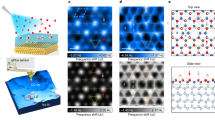Abstract
CONTINUATION of studies1 relating the infra-red absorption spectra and the aluminium substitution for silicon in the chlorite minerals has shown that a similar correlation exists in almost all micas. Regardless of the species under study (that is, muscovite, lepidolite, biotite, phlogopite), the shape of the 9–10µ region of the absorption spectra depicts the amount of aluminium substitution for silicon (Y number) in the basal, tetrahedrally co-ordinated level in the mica structure. The micas may be natural or synthetic. Position of the maxima of absorption is again dependent upon the dominant type of ion in the octahedrally co-ordinated level, the maxima shifting to slightly longer wave-length with increasing atomic weight of the ions in this position.
This is a preview of subscription content, access via your institution
Access options
Subscribe to this journal
Receive 51 print issues and online access
$199.00 per year
only $3.90 per issue
Buy this article
- Purchase on Springer Link
- Instant access to full article PDF
Prices may be subject to local taxes which are calculated during checkout
Similar content being viewed by others
References
Tuddenham, W. M., and Lyon, R. J. P., Anal. Chem., 31, 377 (1959).
Yoder, H. S., in “Clays and Clay Minerals”, Monograph No. 2 (Pergamon Press, New York, 1959).
Author information
Authors and Affiliations
Rights and permissions
About this article
Cite this article
LYON, R., TUDDENHAM, W. Determination of Tetrahedral Aluminium in Mica by Infra-Red Absorption Analysis. Nature 185, 374–375 (1960). https://doi.org/10.1038/185374a0
Issue Date:
DOI: https://doi.org/10.1038/185374a0
This article is cited by
-
�ber die Lithiumgehalte und das Auftreten von Cookeit (Lithiumchlorit) in permischen Sandsteinen von Nordhessen
Contributions to Mineralogy and Petrology (1972)
-
Infrared absorption spectra of micas in the OH stretching region
Journal of Applied Spectroscopy (1972)
-
Review: The crystallization of cordierite glass
Journal of Materials Science (1972)
-
IR spectrum of beryl
Journal of Applied Spectroscopy (1967)
-
Quantitative analysis of clay minerals and their admixtures
Contributions to Mineralogy and Petrology (1966)
Comments
By submitting a comment you agree to abide by our Terms and Community Guidelines. If you find something abusive or that does not comply with our terms or guidelines please flag it as inappropriate.



